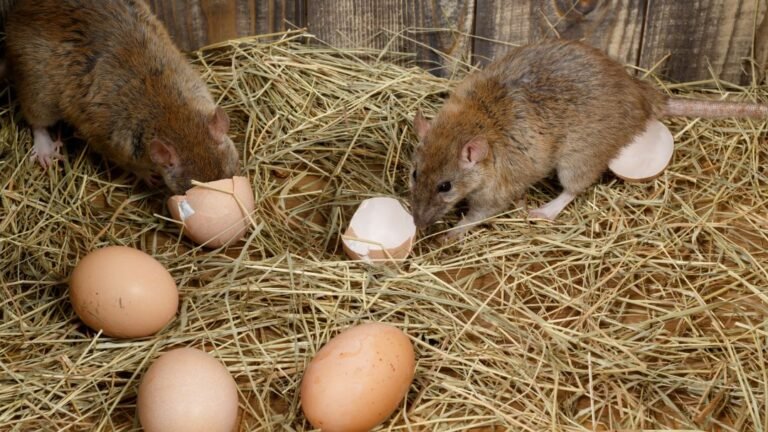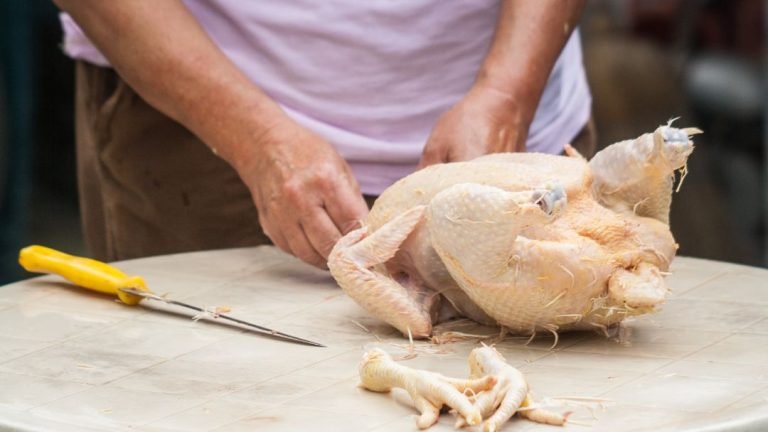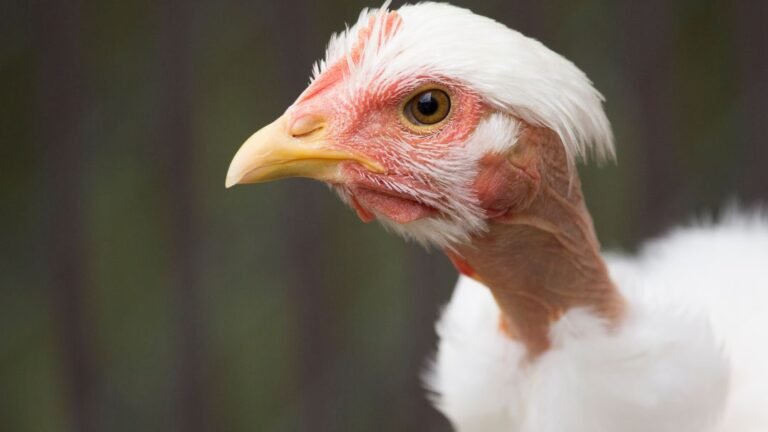Albino chickens are a real phenomenon and not just a myth.
Understanding Albino Chickens
Albino chickens have long fascinated farmers, bird enthusiasts, and researchers alike. With their distinctive white feathers and striking red eyes, these birds stand out from the crowd. But what exactly are albino chickens? Is their existence simply a myth or is there more to these enchanting creatures than meets the eye?
What Are Albino Chickens?
Albino chickens are a fascinating genetic variation of the common chicken (Gallus gallus domesticus). Unlike their pigmented counterparts, albino chickens lack the ability to produce melanin, the pigment responsible for coloration in most animals.
The Genetic Mutation Behind Albinism In Chickens
The absence of melanin in albino chickens is due to a genetic mutation that affects the production of a protein called tyrosinase. This protein plays a crucial role in the synthesis of melanin, and its malfunctioning results in the complete or partial absence of pigment in the bird’s feathers, skin, and eyes.
The genetic mutation responsible for albinism in chickens is inherited recessively, meaning that both parents must carry the gene for it to manifest in their offspring. This is why albino chickens are relatively rare compared to their pigmented counterparts.
Identifying Albino Chickens By Their Physical Characteristics
When it comes to identifying albino chickens, their unique physical characteristics serve as clear indicators. These birds exhibit pure white feathers, devoid of any coloration or patterns. Their skin is also pale, often appearing pinkish, while their eyes display a distinct red or pink hue, owing to the absence of melanin.
Albino chickens are known for their delicate appearance, which is further emphasized by their red or pink wattles and combs – the fleshy protuberances that adorn their heads. Additionally, these birds often have lighter colored beaks and legs compared to their pigmented counterparts.
Common Misconceptions About Albino Chickens Debunked
While albino chickens may seem mysterious and elusive, there are several misconceptions surrounding them that need to be debunked. Understanding the truth behind these misconceptions helps foster a more accurate knowledge of these unique birds.
- Albino chickens are not hybrids: Contrary to popular belief, albino chickens are not a cross between different breeds. They are simply a natural occurrence resulting from a genetic mutation.
- Albino chickens are not sick or unhealthy: Some people assume that albino chickens are weak or prone to health issues. However, albinism itself does not affect the overall health or vitality of these birds. They can thrive just as well as their pigmented counterparts.
- Albino chickens can reproduce and pass on their genes: Although albino chickens may face challenges finding suitable mates, they are perfectly capable of reproducing. If two albino chickens mate, they can pass on the albino gene to their offspring, perpetuating this unique genetic variation.
By dispelling these misconceptions about albino chickens, we can appreciate them for the exceptional and captivating creatures they truly are. Instead of being seen as mythical beings, these birds reflect the awe-inspiring wonders of genetics and the remarkable diversity found in the natural world.
The Health And Well-being Of Albino Chickens
Albino chickens have long caught the attention of poultry enthusiasts and curious onlookers alike. With their striking white plumage and vibrant red eyes, these chickens are undeniably fascinating creatures. However, their unique appearance also raises questions about their health and well-being. In this article, we will explore the special care requirements, potential health issues, ensuring proper nutrition, and providing a safe environment for albino chickens.
Special Care Requirements For Albino Chickens
Albino chickens require a little extra care and attention compared to their pigmented counterparts. Due to their lack of pigmentation, their skin and feathers are more susceptible to sunburn and other skin conditions. To protect them from harmful UV rays, it is essential to provide them with adequate shading. This can be achieved by positioning their coop in a shaded area or by using protective covers or netting. Additionally, it is crucial to keep a watchful eye on their feet, as albino chickens are prone to developing foot problems. Regularly inspecting their feet, providing a clean and dry environment, and offering proper perching options can greatly contribute to their overall well-being.
Potential Health Issues Faced By Albino Chickens
Albino chickens may experience certain health issues that are unique to their genetic makeup. Their lack of pigmentation makes them more susceptible to vision impairments, such as poor eyesight and sensitivity to bright light. Furthermore, albino chickens are prone to being more sensitive to environmental stressors, including extreme temperatures and infections. It is crucial to monitor their health closely, ensure that they have access to fresh water at all times, and consult with a veterinarian if any concerning symptoms arise. By being proactive in their care, we can help minimize the potential health challenges faced by these remarkable creatures.
Ensuring Proper Nutrition For Albino Chickens
Proper nutrition is key to maintaining the health and well-being of albino chickens. These chickens require a balanced diet rich in essential nutrients, vitamins, and minerals. A well-formulated commercial poultry feed that meets the specific nutritional needs of albino chickens is highly recommended. Additionally, adding fresh fruits, vegetables, and occasional protein-rich treats, such as mealworms, can further enhance their diet. It is crucial to provide them with clean water and ensure their feed is fresh and free from contaminants. By focusing on their nutritional needs, we can support the longevity and vitality of these unique chickens.
Providing A Safe And Comfortable Environment For Albino Chickens
Creating a safe and comfortable environment is vital for the well-being of albino chickens. As mentioned before, providing adequate shade and protection from the sun’s harmful rays is crucial. Additionally, ensuring sufficient ventilation in their coop is essential for maintaining optimal air quality and preventing respiratory issues. Regular cleaning and disinfection of their living space, including the coop and surrounding area, will help minimize the risk of infections and parasites. It is important to provide them with enough room to move around freely, roost comfortably, and exercise. By prioritizing their safety and comfort, we can contribute to the overall health and happiness of these extraordinary chickens.
Breeding Albino Chickens
Intro:
Albino chickens have long captured the fascination of poultry enthusiasts and curious minds alike. With their pure white feathers, pink eyes, and unique appearance, these stunning birds are a sight to behold. But are albino chickens real, or just a myth? In this blog post, we’ll delve into the world of breeding albino chickens, exploring the challenges faced by breeders and the importance of maintaining genetic diversity in albino chicken breeding programs.
Breeding Albino Chickens For Desirable Traits
Breeding albino chickens is an art that combines scientific knowledge, careful selection, and a dash of patience. To breed albino chickens for desirable traits, breeders often focus on three main aspects: feather color, eye color, and overall health.
Feather Color: Albino chickens possess white feathers due to a lack of pigmentation. Breeders aim to maintain and enhance this distinct feature, ensuring the purity of white feathers in the offspring. Through selective breeding, which involves pairing albino chickens with other albino individuals or those with specific recessive genes, breeders can increase the likelihood of producing offspring with consistent feather coloration.
Eye Color: One of the defining qualities of albino chickens is their striking red or pink eyes. This eye color results from the absence of melanin, the pigment responsible for coloration. To produce offspring with vibrant eye color, breeders carefully select and pair albino chickens with robust eye pigmentation genes. This deliberate approach allows them to maintain the unique appearance associated with albino chickens.
Overall Health: Albino chickens may be more susceptible to certain health issues compared to their pigmented counterparts. Breeders prioritize the health of their breeding stock to ensure the production of healthy albino chickens. Regular veterinary check-ups and genetic testing help breeders identify potential health concerns and mitigate any risks within their breeding programs.
Challenges Faced In Breeding Albino Chickens
Breeding albino chickens comes with its fair share of challenges. One of the main difficulties breeders encounter is the limited availability of pure albino individuals. Due to the rarity of complete albinos, breeders often rely on chickens with partial albino traits or those carrying the recessive albino gene.
Another common challenge is the potential for genetic disorders and health complications in albino chickens. As albino genes are recessive and can be associated with various genetic abnormalities, breeders must take meticulous care to avoid breeding individuals with detrimental genetic conditions. This process requires careful screening and selecting breeding pairs to reduce the risk of passing on genetic diseases to future generations.
Breeding albino chickens also poses difficulties in maintaining desired traits, such as feather color and eye pigmentation, while ensuring genetic diversity. Focusing solely on breeding for specific traits can lead to a limited gene pool, reducing genetic diversity and potentially compromising the overall health and viability of the breed. Therefore, breeders must strike a balance between selective breeding for desirable traits and promoting genetic diversity within albino chicken populations.
Maintaining Genetic Diversity In Albino Chicken Breeding Programs
Genetic diversity plays a crucial role in the long-term sustainability and vitality of any breeding program, including those focusing on albino chickens. To maintain genetic diversity, breeders employ strategies such as outcrossing and careful selection.
Outcrossing involves introducing genetically diverse individuals from outside the breeding population to avoid inbreeding. By bringing in new genetic material, breeders can offset the potential negative effects of narrowing the gene pool and improve the overall resilience and vigor of the breed.
Additionally, breeders prioritize careful selection by analyzing the genetic makeup of potential breeding pairs. This approach helps identify individuals with diverse genetic backgrounds that can contribute positively to the breeding program. By intentionally selecting individuals with a broad range of genetic traits, breeders can maintain a healthy gene pool within albino chicken populations.
In conclusion, breeding albino chickens requires a precise balance of selecting desirable traits while maintaining genetic diversity. By understanding the challenges faced in breeding albino chickens and employing strategies to overcome them, dedicated breeders contribute to the preservation and enhancement of these captivating avian wonders.
Albino Chickens In Agriculture And Farming
Albino chickens have always captured the imagination of farmers and animal enthusiasts alike. With their snowy-white feathers and striking red eyes, these rare birds are the subject of fascination and speculation. Are albino chickens real, or are they just a myth? Let’s delve into the world of albino chickens in agriculture and farming to find out.
The Role Of Albino Chickens In Egg Production
Albino chickens, contrary to popular belief, can indeed contribute to egg production. These unique birds can lay eggs with the same quality as their non-albino counterparts. In fact, some studies suggest that albino chickens may even have a higher rate of egg production than other breeds. This presents a promising opportunity for farmers and egg producers seeking to diversify their flocks and meet the growing demand for high-quality eggs.
The white plumage of albino chickens can also be an advantage in certain regions. In areas with hot climates, the lighter feathers can help reflect sunlight, keeping the birds cooler and potentially improving their overall health and productivity.
Utilizing Albino Chickens For Meat Production
Albino chickens can also be a valuable asset when it comes to meat production. Their unique appearance can make them a sought-after option in specialty markets and restaurants looking to provide unique and visually appealing delicacies. Albino chickens typically have a similar meat quality and taste to other breeds, making them a viable choice for consumers seeking a distinct culinary experience.
In addition to their potential value in specialty markets, albino chickens can also be raised for personal consumption, providing a reliable source of lean and healthy meat for individual households. Their distinct appearance and the knowledge that they were homegrown can add to the satisfaction of enjoying a delicious meal.
Challenges And Opportunities In Integrating Albino Chickens Into Farming Practices
Integrating albino chickens into traditional farming practices comes with its fair share of challenges and opportunities. Let’s explore some key considerations:
| Challenges | Opportunities |
|---|---|
|
|
By addressing these challenges and capitalizing on the opportunities, farmers can successfully integrate albino chickens into their farming practices, diversifying their product offerings and meeting the demands of an evolving market.
Albino chickens, contrary to being mere myths, have a real role to play in agriculture and farming. From their contribution to egg production to their potential in meat markets, these unique birds offer both challenges and opportunities for farmers willing to explore new horizons. By embracing the distinctiveness of albino chickens, farmers can shape a more diverse and sustainable future for their farms and communities.
The Fascinating History And Cultural Significance Of Albino Chickens
Albino chickens have always intrigued humanity with their unique appearance and mysterious nature. These extraordinary creatures have been the subject of fascination in various cultures and hold a significant place in ancient folklore, mythology, and traditions. Let’s explore the captivating history and cultural significance of albino chickens.
Albino Chickens In Ancient Folklore And Mythology
In ancient folklore and mythology, albino chickens often held a special place. They were seen as bearers of good fortune and were believed to possess mystical powers. These enchanting creatures were often associated with sun gods and celestial beings, symbolizing purity and divine protection. Albino chickens were considered as sacred beings in many cultures and were often offered as sacrifices and used in sacred rituals.
Albino Chickens In Different Cultures And Traditions
Across different cultures and traditions, albino chickens have played diverse roles. In some societies, they were believed to bring prosperity and happiness, and their feathers were used in ceremonial headdresses or garments worn during significant celebrations. Additionally, albino chickens were valued for their rarity and uniqueness, making them a symbol of status and wealth.
On the other hand, some cultures associated albino chickens with negative connotations or even considered them as omens of bad luck. Depictions of albino chickens in folklore and literature varied from being demonic or cursed creatures to having the ability to ward off evil spirits and protect households.
The Symbolism And Superstitions Surrounding Albino Chickens
Albino chickens have long been associated with symbolism and superstitions. In different parts of the world, they are believed to possess various powers, including the ability to ward off evil, bring fertility and abundance, or even predict the future. The unique combination of their white feathers and red eyes has made them captivating subjects of cultural beliefs and traditions.
Across different societies, people hold superstitions about encountering albino chickens. Some believe that spotting an albino chicken brings good luck, while others associate it with impending misfortune. These superstitions have passed down through generations, reflecting the enduring interest and awe surrounding these marvelous creatures.
| Symbolism and Superstitions | Meaning |
|---|---|
| Protection | Albino chickens are believed to provide protection against evil spirits and bring blessings to households. |
| Purity | Their white feathers symbolize purity and divine qualities. |
| Uniqueness | The rarity of albino chickens contributes to their association with uniqueness, prestige, and even wealth. |
In conclusion, albino chickens have left an indelible mark on human history and culture. From ancient folklore and mythology to diverse cultural traditions, these captivating birds continue to captivate our imagination. Whether considered as omens of good fortune or carriers of supernatural powers, albino chickens have embedded themselves in the fabric of human beliefs and symbolism.
Conclusion
Albino chickens are not a myth but a rare genetic occurrence. These unique birds lack pigmentation, resulting in their white feathers, pale beaks, and pinkish eyes. Despite their striking appearance, albino chickens face various health challenges and are often more susceptible to predators.
While they may not be common, their presence adds to the diverse world of poultry, highlighting the wonders of nature. Keep exploring and learning about these fascinating creatures!



